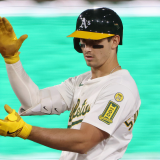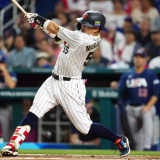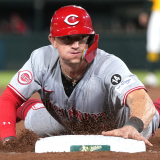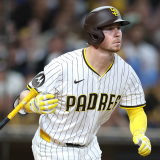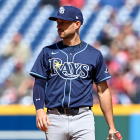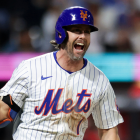
Why the Dodgers' handling of Kenta Maeda highlights the potential conflicts of interest with contract incentives
Maeda has been pitching out of relief at a time when he's nearing certain bonuses
The Los Angeles Dodgers can become the first team to clinch their division on Tuesday, either by defeating the Baltimore Orioles or having the New York Mets top the Arizona Diamondbacks. Whenever it happens, the Dodgers are certain to enter October as the favorites to win the National League pennant. After all, the Dodgers' run differential (plus-234) is twice as good as the next-best NL club -- the Washington Nationals, who will have to brave the Wild Card Game.
For as good as the Dodgers are, and as happy as these times should be, one blemish has emerged as of late: their deployment of Kenta Maeda, and how it impacts his pay.
Maeda, for those unaware, was recently reassigned to a relief role after spending the season in the rotation. He has a 102 ERA+ and 3.40 strikeout-to-walk ratio on the year -- both marks are beyond acceptable for a mid-rotation starter. This isn't the first time the Dodgers have asked Maeda to pitch out of the bullpen, but there are questionable aspects to the decision.
Maeda has one of the least-favorable contracts in the sport: an eight-year pact that guarantees only $25 million and is incentives heavy to the point of being laughable -- the result, reportedly, of the Dodgers finding "irregularities" during his physical. (Why the Dodgers would want eight seasons of someone they deem an injury risk is a question worth asking.) Maeda's contract is structured in a way where he's compensated best as a starter, based on innings and starts.
According to Cot's Contracts, Maeda is paid $1.5 million for his 25th, 30th, and 32nd starts of the year. He's also paid $250,000 for every 10th inning beginning with his 90th. As it stands, he's made 26 starts and has thrown 146 innings in 2019. Had he been allowed to continue starting, he would've topped 30 starts and -- based on his average -- threatened 170 frames. In other words, Maeda would've received another $2 million for hitting those marks. (And the Dodgers, for their part, would then have that much less separation from the luxury-tax line.)
Instead, the Dodgers have shifted Maeda to the bullpen again, as they have in two of the three prior seasons. To what end? The move was supposed to be two-pronged in intent: 1) allow Julio Urias to stretch back out and 2) prepare Maeda for the postseason, when he'll pitch in relief. Neither adds up, however: Urias is already returning to relief after two short starts, and Maeda's current role does not match up with the one he's expected to fill come October.
Dave Roberts said Julio Urias is going back to the bullpen.
— Ken Gurnick (@kengurnick) September 8, 2019
This isn't us speculating, either. Take a look at how manager Dave Roberts described what he anticipates from Maeda come the playoffs, per Pedro Moura of The Athletic:
"In the postseason, Kenta's value essentially is to be available every game," Roberts said. "And so, a long guy is definitely not Kenta. Kenta is to pitch leverage innings in the postseason, very important innings."
It's fair to suggest that a pitcher moving from the rotation to a nightly relief role could benefit from a transition period. But the Dodgers have asked Maeda to pitch in relief twice so far, and both times he's thrown four innings, including after Urias's most recent start. If the Dodgers are willing to use Maeda as a long reliever in September, why wouldn't they just keep him in the rotation -- other, that is, than to potentially avoid paying him his bonus for reaching 30 starts?
Now, obviously, it's possible this is all a coincidence. The Dodgers do have a ton of quality starters, and the case can be made that Maeda is the weakest of the bunch -- especially with Urias removed from the equation. Maeda has also already thrown more pitches this year than he had in his previous two seasons, and the Dodgers may have concerns about how he'll hold up deeper in the year, meaning his move to the bullpen is about preservation as well as preparation. Additionally, if the Dodgers wanted to nickel and dime Maeda, they could have prevented him from making his 25th start. Besides, permitting him to rack up innings in relief could still cost them money, albeit not as much as they would've had to pay out if he remained in the rotation.
Even so, there's a thin line between operating in good and bad faith, and incentives tied to player usage -- especially as it pertains to pitchers -- create the potential for these kinds of conflicts of interest. Some might claim it's cynical to even raise the point, but remember: baseball has seen teams operate in shady ways before. In 2017, the Los Angeles Angels flipped Bud Norris and Jesse Chavez's roles in order to avoid paying each incentives that would've tallied $750,000 -- a trifling amount for a MLB team.
Heck, even the Dodgers have tip-toed the line. In 2015, they limited Brandon Beachy to two appearances and eight innings -- had he reached 10 innings, his contract would have included a $250,000 buyout on the subsequent club option. Beachy performed poorly enough for everyone to handwave off suspicions of wrongdoing, but it's always valid to wonder about these things given how teams have historically operated.
The Dodgers have had a brilliant season, and could well soon appear in a third consecutive World Series. They don't have to operate in a way that raises eyebrows about their true intent, which makes the possibility of suppressing Maeda's earnings all the more maddening.


